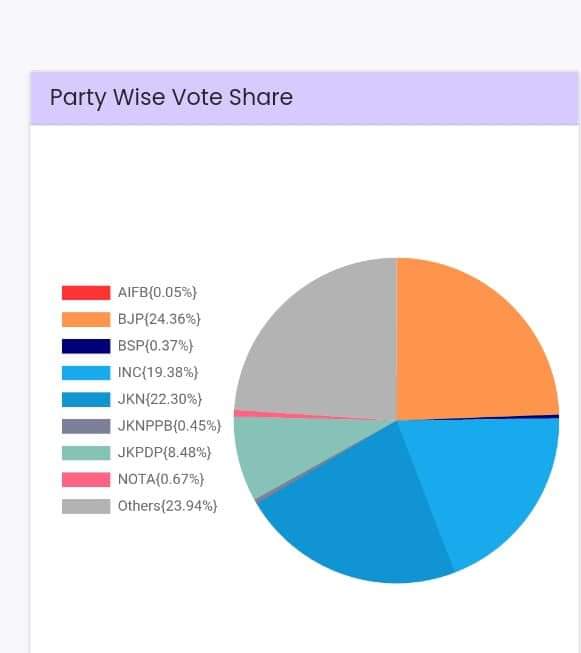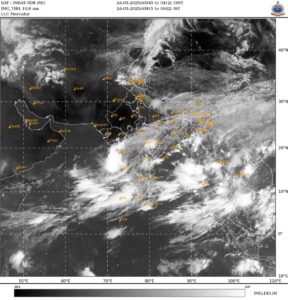General Elections 2024: Party-wise Vote Share in J&K and Its Possible Impact on Assembly Elections

As we all know that stage for Assembly Elections has been set in Jammu and Kashmir & every party is doing its best job for formation of Govt in JKUT. Which party in this elections has got the mandate it is still in the womb of time. INC has come in an alliance with NC & all others are going on their own. So it’s very interesting that which party or alliance emerge the winner. But if we analyse the vote percentage share data of the recently concluded 2024 Jammu and Kashmir General Election Results, we may have insight into the possible outcomes.
2024 Parliamentary Elections in Jammu and Kashmir have produced intriguing results, reflecting the diverse political landscape of the region. The election saw a varied distribution of votes across multiple parties, indicating the complex dynamics at play in this region.
Key Parties and Their Vote Shares
1. Bharatiya Janata Party (BJP) – 24.36%:
The BJP emerged as the party with the highest vote share, securing 24.36% of the total votes. This strong performance highlights the party’s continued influence in the region, particularly in areas where national issues resonated with voters.
2. Jammu and Kashmir National Conference (JKNC) – 22.30%:
The JKN followed closely with 22.30% of the vote share. This performance is indicative of the party’s deep-rooted presence and appeal, especially among those who favor a regional approach to governance.
3. Indian National Congress (INC) – 19.38%:
The Congress party managed to garner 19.38% of the votes, reflecting its persistent appeal among a significant portion of the electorate. This result also indicates the party’s potential role as a key player in coalition-building.
4. Jammu and Kashmir Peoples Democratic Party (JKPDP) – 8.48%:
The JKPDP secured 8.48% of the votes, showing its continued relevance in the region, though with a more limited reach compared to the major players.
5. Others – 23.94%:
A notable 23.94% of the votes went to smaller parties and independent candidates, underlining the fragmented nature of the electorate and the presence of localized issues that might not align with the platforms of the major parties.
Minor Parties and Independents-
AIFB (All India Forward Bloc) – 0.05%: The AIFB, traditionally a minor player, received only 0.05% of the votes, reflecting its minimal impact in the region. –
BSP (Bahujan Samaj Party) – 0.37%: The BSP managed to capture 0.37% of the votes, indicating a small but notable presence in the region.-
JKNPPB (Jammu and Kashmir National Panthers Party) – 0.45%:
The JKNPPB received 0.45% of the vote share, maintaining its status as a minor yet established player in the state’s political scene.-
NOTA (None of the Above) – 0.67%:
The 0.67% vote share for NOTA suggests that a fraction of the electorate expressed dissatisfaction with all the candidates, opting instead for this protest option.
This vote share data from the recent Jammu and Kashmir Parliamentary elections provides crucial insights into the political landscape and potential scenarios for upcoming elections.
With the National Conference (NC) forming an alliance with the Indian National Congress (INC), and the Bharatiya Janata Party (BJP) securing the highest individual vote share, the dynamics for future electoral contests are becoming clearer.
Here’s an analysis of how this vote share can influence future elections and the possible outcomes:
1. Impact of NC-INC Alliance:
Combined Vote Share: The NC secured 22.30% of the vote, while the INC garnered 19.38%. Together, their combined vote share reaches 41.68%, which positions them as a formidable force against the BJP, which individually secured 24.36%. This alliance could significantly challenge the BJP in constituencies where the combined influence of NC and INC voters could tip the balance in their favor.
Regional Strengths:
The NC’s regional stronghold, coupled with the INC’s broader appeal, especially in areas where it retains a loyal voter base, could result in a more focused and strategic campaign. This collaboration can also help consolidate anti-BJP votes, reducing the chances of vote splitting among opposition parties.
Voter Appeal:
The alliance might appeal to voters who are looking for a coalition that balances both regional and national interests, particularly those who may have been undecided or dissatisfied with single-party dominance.
2. Prospects for the BJP:
Strong Vote Base:
The BJP’s 24.36% vote share, while not the majority, still represents a significant portion of the electorate. The party has shown resilience and can build on this base by focusing on specific issues that resonate with voters, such as national security, development, and integration policies.
Targeting Swing Voters:
To counter the NC-INC alliance, the BJP may need to target swing voters and focus on regions where their support is substantial but not overwhelming. Emphasizing issues of local significance and addressing any regional grievances could help the BJP retain and even expand its voter base.-
Possible Alliances:
The BJP might also consider forming strategic alliances with smaller regional parties or independent candidates who can bring additional votes. This could help the BJP cross the threshold needed to counter the NC-INC alliance effectively.
3. Potential Outcomes:
Competitive Elections:
Given the close vote shares, future elections are likely to be highly competitive. The NC-INC alliance will make the contest more challenging for the BJP, especially in constituencies where the combined opposition vote share can surpass that of the BJP.
Coalition Governments:
If the trends from the current vote share hold, coalition governments may become a reality, with no single party gaining an outright majority. This could lead to more negotiations and power-sharing agreements, particularly if the NC-INC alliance succeeds in securing a majority of seats.
Regional Polarization:
The vote share data also suggests potential regional polarization, with certain areas strongly favoring the BJP and others leaning towards the NC-INC alliance. This could lead to targeted campaigns by both sides, focusing on consolidating their respective strongholds while attempting to make inroads into each other’s territories.
Conclusion:
The vote share data from the 2024 elections sets the stage for a highly competitive political environment in Jammu and Kashmir. The NC-INC alliance poses a significant challenge to the BJP, but the BJP’s solid vote base and strategic maneuvering could still secure a substantial number of seats. Future elections are likely to hinge on coalition-building, targeted voter engagement, and addressing key regional issues. Both the BJP and the NC-INC alliance will need to adapt their strategies to the evolving political landscape to achieve their respective goals.





